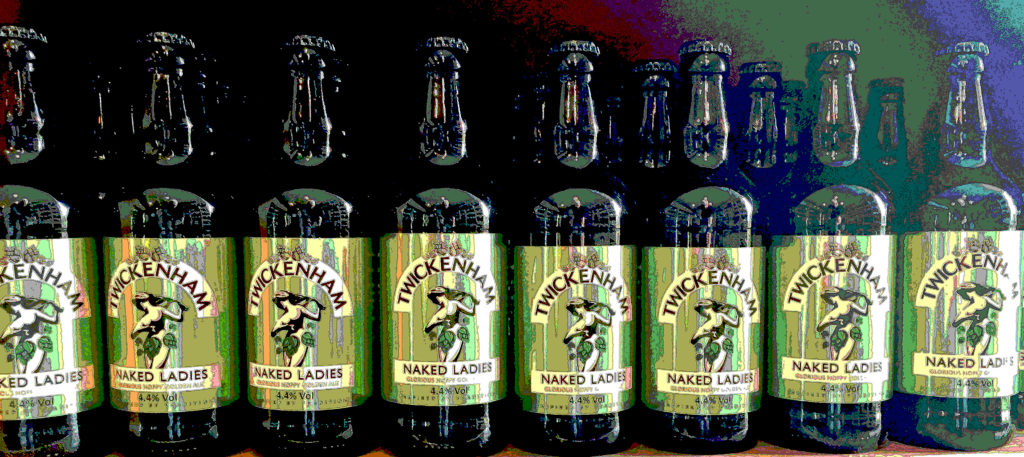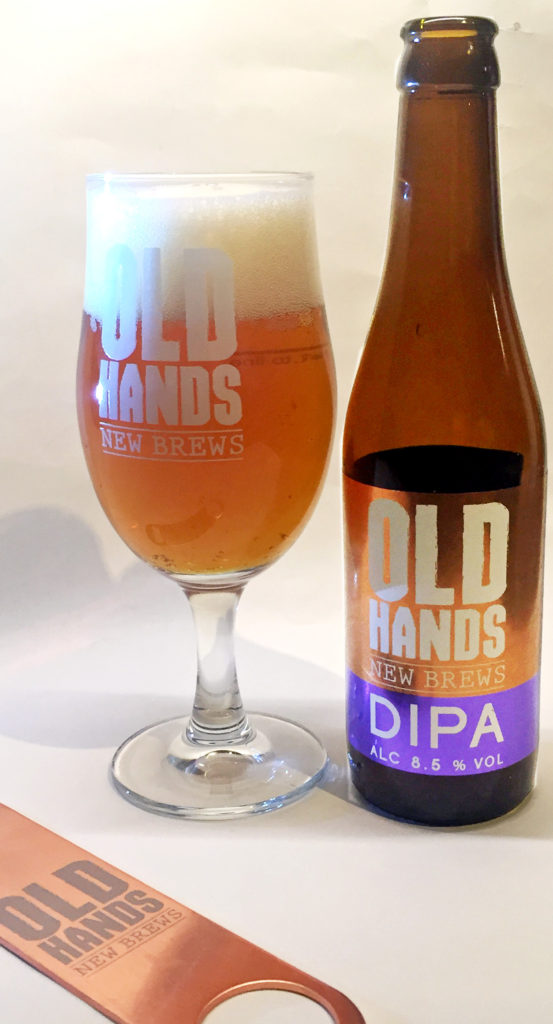Quick: what’s the oldest microbrewery in London?
The answer, to stop you looking it up, is Twickenham, which despite not even being a teenager yet, today, after the sale of Meantime, bears the mantle of the capital’s currently longest surviving independent new brewery. Which is more of a burden than you might at first reckon.
The brewery produces some lovely, and deservedly highly regarded cask and bottled beers: Naked Ladies, named for a set of statues of nymphs in a public garden by the Thames, is an excellent and locally very popular American-influenced 4.4 per cent alcohol best bitter, firmly but lightly flavoured with Celeia and Chinook hops, a good session brew and a reliable banker found on bar tops across West London and, in its bottled version, in a large number of off-licences around its home area, including Marks & Spencer and Waitrose, as well as Majestic Wine outlets nationally.
 But the brewery’s full name – Twickenham Fine Ales – is a reflection of the astonishingly different environment in which it was founded, just a dozen years ago. We’ve forgotten, I think, how unlike today the British beer scene was when Tony Blair was prime minister and Michael Howard leader of the Conservative Party. Beer in Britain went through a complete spin-around in 2009/2010, and I suspect, we can only look back now, half a decade on, and think: “Wow – what happened there?” We all saw these new breweries opening from 2009 onwards, in London in particular, we all saw how they were highly influenced by what was happening in the United States, with massively hoppy beers, big stouts, sour beers, strange obscure offerings such as Gose, and oriented towards keg delivery, towards cans, towards 33cl bottles kept in the chiller, and I’m not sure we were able to see quite what a caesura, a total break, this was in the history of British brewing, what a revolution was happening around us. “Fine Ales”? Grandad, that’s so 20th century.
But the brewery’s full name – Twickenham Fine Ales – is a reflection of the astonishingly different environment in which it was founded, just a dozen years ago. We’ve forgotten, I think, how unlike today the British beer scene was when Tony Blair was prime minister and Michael Howard leader of the Conservative Party. Beer in Britain went through a complete spin-around in 2009/2010, and I suspect, we can only look back now, half a decade on, and think: “Wow – what happened there?” We all saw these new breweries opening from 2009 onwards, in London in particular, we all saw how they were highly influenced by what was happening in the United States, with massively hoppy beers, big stouts, sour beers, strange obscure offerings such as Gose, and oriented towards keg delivery, towards cans, towards 33cl bottles kept in the chiller, and I’m not sure we were able to see quite what a caesura, a total break, this was in the history of British brewing, what a revolution was happening around us. “Fine Ales”? Grandad, that’s so 20th century.
The problem for Twickenham in this new environment is that however good its beers, they look a little less than cutting edge alongside, say, Beavertown and its graphically furious cans. It is not through chance that Twickenham’s new West London rival, the Wimbledon brewery, sells its beers in 33cl bottles that sit without appearing out of place in the chiller cabinet together with craft beer offerings from around the world, while Twickenham’s ales, in their 50cl bottles, have to go and squat with the Wadworths, the Ringwoods, the Timothy Taylor’s – all beers your dad drinks.
The result, Ben Norman, Twickenham’s sales and marketing director, told me when I visited the brewery last week, was that bar owners today say to him: “I love your beers, but I can’t stock them – they’re not right for my outlets.”
Completely revolutionising the line-up is clearly not the answer: Twickenham’s current beers have too many (admittedly older) fans. So to try to get into bars where the brewery’s “old school” beers do not currently fit, it has just launched an entirely separate brand of “craft beers”, on keg and in 33cl bottles, with totally different imagery, and with the “Twickenham” name barely visible. The beers are being sold under the Old Hands brand, the idea being that even 12 years is four times the experience many London breweries currently have, with the tagline “Old Hands, New Brews”, and an emphasis that they come from “London’s oldest microbrewery”.
I’m strongly biased in favour of Twickenham: I’ve been a big fan since it opened in 2004 in premises less than half a mile from my then house. What I like about the brewery’s beers is the unfussed competence they exhibit: founder Steve Brown seems always to have been able to hire brewers who are totally on top of the job. Don’t necessarily trust me, therefore, when I say that the first batch of Old Hands beers is a terrific start that deserves to do very well: they may all be new styles to the brewery, but that “house competence” is still there, and not one is a disappointment or a distress.

I have to say, though, I’m not totally convinced about the branding: I’m a long way from the target audience, “typically younger craft beer drinkers”, being an untypically older craft beer and traditional ales as well drinker, but it seems to me that downplaying the Twickenham name is an error. The brewery has a reputation for quality, and making the Twickenham name more prominent would have helped introduce the Old Hands range to fans of Twickenham’s current, more traditional beers without putting off younger drinkers, I believe, while Twickenham’s reputation for quality brews would reassure everybody that the new line-up was worth risking an experiment.
Do, certainly, try for yourself. The Old Hands range has one beer designed to be a regular, Session IPA, 4.7 per cent abv, hopped with Mosaic, just 25 IBUs but buckets of flavour, as good a lower-gravity American Pale Ale as you’ll find in a very long journey, plus four others that will change regularly, according to Ben Norman, although I’ve tried them all and I reckon there are at least a couple that popular demand will insist be made part of the permanent line-up. The others, currently, are Strawberry Saison, 6 per cent, made with 300kg of strawberries, with the strawberries, as you would expect from Twickenham, perfectly balanced in a refreshing pale brew with just the right amount of tartness; Coconut Porter, made with 150kg of roasted coconut (a bugger to get out of the brewing vessels afterwards) and 50kg of cocoa nibs, which was extremely drinkable even for me, and I’m right at the back of the queue for the coconut beer fanclub; Rauch Beer, another style at the very bottom of my personal love-list, but made once again with Twickenham’s signature precision touch, so that again, even I enjoyed it; and a Double IPA at 8.6 pr cent, made with the help of the award-winning home brewer Fraser Withers from up the Thames at West Molesey, with Mosaic, Simcoe and (a new one to me) Azacca* hops, to give 70 IBU. Eminently drinkable, like all Twickenham beers, this is that almost paradox, a restrained DIPA. If other dippers are a hollering din, the Old Hands version is a pleasant and refined conversation on the virtues of masses of hops in a small glass.
We’ve not seen a shake-out yet in the London brewing scene, though numbers do now seem to have at least stabilised. While there will always be a market for the new (hence the decision to make Old Hands a revolving line-up), I can’t see anything but an increasing requirement for quality and reliability as the craft beer market matures, and not just because they’re my local brewery, I think Twickenham is in a great place to thrive with both its “dad” beers and its new “craft” line. And maybe they will eventually feel they can make the Twickenham name a bit bigger on the Old Hands labels …
* Named for the Haitian god of agriculture and developed by the American Dwarf Hop Association: a cross between the Japanese hop Toyomidori and an unknown variety, Toyomidori itself being a cross between Northern Brewer (a Golding descendant) and a wild American hop developed at Wye College in Kent and known as OB79, which appears in several hop family trees.

Ludicrous. Everywhere in the “craft beer” scene there is chat about how THEY care about flavour, not branding, with the requisite sneering about drinkers of mass-market beers supposedly brainwashed by advertising … and yet you see established breweries forced to adopt garish, juvenile packaging to chase sales in the “craft” market.
Seems a bit rich to blame this on ‘craft beer’ people. I don’t think this is something they’ve asked for or particularly respond to. Quite the opposite if the Marston’s hoo-ha the other week is anything to go by.
They might say, ‘That branding is naff’, but I’m not sure that means, ‘So please make it look a bit like BrewDog’, or, indeed, stops them buying the beer anyway, and buying it repeatedly if it tastes nice.
When it works, to an extent, is when the sub-brand or spin-off actually reflects a difference in the product, i.e. the ‘craft’ beers are stronger/hoppier/weirder. Too often, it’s just the same old beers in fancy dress.
In general, I think there’s a bit of a myth that craft beer scenesters never drink, say, bitter — that might be true of a hardcore but there are plenty of people raving about limited edition bottle releases who also Tweet pics of their pints of London Pride.
(DISCLOSURE: the other half accidentally got plied with free samples of beer from this brewery the other week.)
Interesting post, BTW, Martyn.
I’m not entirely sure – for my part, I’m more tempted to try something from a brewery that I don’t really know if it roughly looks the part, and Twickenham would come under that heading. I’d guess that I’m not alone on this.
On the other hand I’d see that as a rough filtering mechanism for dealing with the baffling number of beers that are available – for breweries that people are already familiar with, the branding doesn’t seem to be a dealbreaker even for Serious Craft People so long as the product’s known to be up to snuff – I mean, look at Cantillon. And similarly, smarty designed 330ml bottles won’t do you much good in those circles if you’ve already got a bad reputation for brewing.
The other interesting thing about 33 cl bottles is that you can only get 33 cl of beer into them. I’ve heard rumours that some brewers’ 33 cl bottles of beer sell at the same kind of retail price as others’ 50 cl bottles. Presumably this is because the beer is 50% more awesome.
The spread of 330 ml bottles is unwelcome, in my view, given that, as Phil notes, the price frequently appears to have little relation to the size of the bottle, or even, in some cases, to the strength of the beer. Moreover, it’s a pity that pint (or 568 ml) bottles seem to have disappeared completely. The ironic thing is that you can find pint tins of Eastern European lager in many Polish and Baltic shops in the UK – often described as a “pinta”. These are genuine 568 ml pints, rather than the 500 ml measure which is often described as a “pint” in Paris, for example.
ZeroDegrees opened in August 2000.
It’s a restaurant, not a microbrewery.